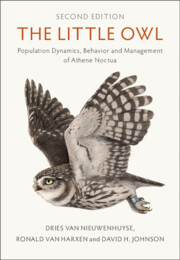Book contents
- The Little Owl
- The Little Owl
- Copyright page
- Contents
- Foreword
- Preface
- Acknowledgements
- Executive Summary
- Chapter 1 Introduction: Framework
- Chapter 2 History and Traditions
- Chapter 3 Fossil Evidence, Taxonomy and Genetics
- Chapter 4 Morphology and Body Characteristics
- Chapter 5 Distribution, Population Estimates and Trends
- Chapter 6 Habitat
- Chapter 7 Diet
- Chapter 8 Breeding Season
- Chapter 9 Behavior
- Chapter 10 Population Regulation
- Chapter 11 Management and Conservation
- Chapter 12 Research Priorities
- References
- Index
Chapter 7 - Diet
Published online by Cambridge University Press: 29 September 2023
- The Little Owl
- The Little Owl
- Copyright page
- Contents
- Foreword
- Preface
- Acknowledgements
- Executive Summary
- Chapter 1 Introduction: Framework
- Chapter 2 History and Traditions
- Chapter 3 Fossil Evidence, Taxonomy and Genetics
- Chapter 4 Morphology and Body Characteristics
- Chapter 5 Distribution, Population Estimates and Trends
- Chapter 6 Habitat
- Chapter 7 Diet
- Chapter 8 Breeding Season
- Chapter 9 Behavior
- Chapter 10 Population Regulation
- Chapter 11 Management and Conservation
- Chapter 12 Research Priorities
- References
- Index
Summary
The Little Owl has a generalist diet and takes a high diversity of small prey. It eats a range of small-sized prey across its entire distribution area. The diet varies with the season and the geographical area. From north to south and from winter to summer, an increase in the numbers of insects in the diet has been observed. However, small mammals remain the key prey category by biomass and energetic yield, contributing significantly to the ecology and welfare of the species. For insect-eating owl species it is difficult to get a true picture of its diet by only studying its pellets or prey remains in nestboxes, because they catch lots of prey, the remains of which are hard to find and identify in pellets. We present their relative proportion. In this chapter we look at this prey diversity through time and space, and focus on the hunting method of the owl, as well as caching behavior in larders. We offer a thorough review of the owl’s diet and individual prey species, with attention given to the importance of micromammals. Pellet contents are described in detail and comprehensive results of camera-observed breeding seasons are presented, principally stemming from our own research over 17 breeding seasons by camera observation in 2002-2020, totaling 34 916 prey items.
- Type
- Chapter
- Information
- The Little OwlPopulation Dynamics, Behavior and Management of <I>Athene noctua</I>, pp. 271 - 323Publisher: Cambridge University PressPrint publication year: 2023

